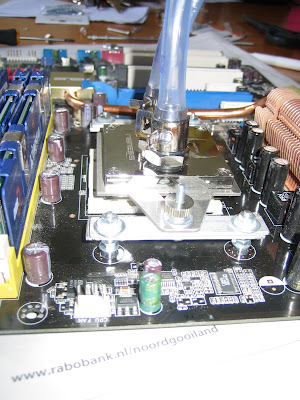Having the watercooling built in that is it? Not quite. The cpu temperature looks 5 degrees celsius lower than before at a first glance, but after running longer the temperature rises to the same level as before between 30 en 35 degrees celsius. And higher, so we are now pumping around warmth.
I have analyzed the problem and these are the problems that need to be addressed:
1. the sequence is wrong it should be pump->cpu->radiator
2. the fan blows warmth through the radiator into the case
3. the proportion of coolant is too low
One can also wonder if the radiator shouldn't be outside of the case.
Another issue is the videocard. Currently I have installed an eVGA 8800GT and is getting really hot (about 75 degrees celsius). A videocard cooling block is nice to have, but not for the moment.
To summarize the current configuration:
AMD Athlon X2 5600+@2800MHz (stockspeed)
ASUS M2N-SLI Deluxe
4 x Kingston HyperX 512MB 4-4-4-12 (800 MHz)
eVGA 8800GT Superclocked (cpu/mem 650MHz/1900MHz)
3 x SATA HDD
Cooler Master STC-01 Stacker
Cooler Master STF-B01-E1 Cross Flow Fan
With 3DMark2006 op 1280x1024 default this setup runs at 10300 3Dmarks.
Next step is point 2. I have to come up with an alternative mounting solution. The rest is for tomorrow.
 And what are the results? I like it very much temperature wise. At idle the cpu temperature remains at 24 degrees Celsius and the case temperature now remains at 27 degrees Celsius. Look at the screenshot I toch of the hardware monitor of CPUID.
And what are the results? I like it very much temperature wise. At idle the cpu temperature remains at 24 degrees Celsius and the case temperature now remains at 27 degrees Celsius. Look at the screenshot I toch of the hardware monitor of CPUID.











